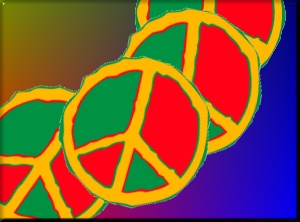
From Draft NOtices, July—September 2010The Peace Symbol: Fashion or Political Statement?— Nancy Cruz and Paula Hoffman-Villanueva |

|
|||
They are everywhere! Peace symbols are on clothes, backpacks, jewelry, shoes, school supplies, towels and body parts! We started wondering what this means. Is it just a fad, in the same way that Che Guevara was a few years ago? Young people loved Che’s face on t-shirts, but many knew little more about him than what they had seen in Motorcycle Diaries. Or is the new popularity of the peace symbol more than just a fashion statement? A certain level of consciousness because of the wars? A real desire for peace? A new and growing generation of anti-war activists? Lady GaGa, a well-known pop singer, says that the peace symbol tattoo on her inner wrist is to help her “keep in mind the important things.” Is her influence opening the minds of young people? It’s happened before. It could happen again. So we decided to hit the local mall in San Diego and ask young people why they were wearing the peace symbol. We felt that pencil-and-paper surveys would put off a number of shoppers, so we decided to have casual conversations with them. The questions were asked by Nancy Cruz, who is a UCLA junior, community activist, and member of the counter-recruitment organization Project on Youth and Non-Military Opportunities (Project YANO). In each small group of two or three young people approached by Nancy, at least one of them stated that they did have something with the peace sign on it. She then asked them why they liked it/wore it and what it meant to them.
At this point, feeling quite disappointed that the peace symbol is nothing more than a shallow fashion statement for today’s youth, we decided to try one or two more times. Joanna gave us hope:
Well, that was an improvement. As we left the mall, Nancy decided to approach one more small group of people who were waiting for their rides home:
As we walked back to the car, Nancy made the observation that we would have gotten different results if we had gone to a college campus to ask the questions. Undoubtedly, she was right. And perhaps, after each interview, we should have handed out a small paper explaining the history of the peace symbol (a “teachable moment,” after all). What else can we conclude about our shopping mall survey? What started as a somewhat light curiosity regarding the peace symbol became a sad understanding. It seems that the fashion industry has succeeded in minimizing a significant political symbol. Young people are wearing paisley “hippie” styles and peace symbols, but they are making NO connections to any anti-war movement. No wonder military recruiters love going to the shopping malls! And what did we expect of a generation of young people who were toddlers when we invaded Iraq? We have been at war for as long as they can remember. Tragically, for them war is normal. They have no reason to question something that has always been a part of their reality. Combine this with the fact that, at their age, fashion and peer pressure are their main concern. We should not be surprised by our survey results. In the Winter 2009-10 issue of Rethinking Schools, a well-respected publication for progressive teachers (www.rethinkingschools.org), the editorial states that there is too much silence in the classrooms regarding war. This silence is potentially very dangerous. In pointing out that 9-11 happened when young teens were toddlers, they come to a disturbing conclusion:
This is precisely why the work of groups like Project YANO is so important. The organization, at its core, has always recognized that educating our youth is crucial. So, if anything, the peace symbol survey is just a confirmation of our need to work harder. The Pentagon knows that 14- to 17-year-olds are not equipped to understand the consequences of going into the military. Thus, we see JROTC programs and recruiters constantly on campus. In Project YANO’s most recent fund appeal letter, reference was made to a young man who had, while still in high school, enlisted under the Delayed Entry Program. When he indicated to recruiters that he wanted to change his mind, he was subjected to frightening intimidation and threats. But wait. Is it all bad? We have seen, in recent years, many thousands of young high school students participate in immigration marches. They have walked out of their high schools in protest. Younger members of Project YANO have gone in caravans to Arizona to protest the state’s law targeting immigrants. We also saw hundreds of high school students come together to successfully remove shooting ranges from San Diego high schools and advocate for more college-prep courses. Obviously, when aware of the issues that concern them and affect them deeply, our young people are passionate and not afraid to speak up. We just need to do a better job of informing them. Should we set up a classroom at the mall? Of course, a little help from Lady GaGa would go a long way. Hey, Lady Gaga, would you please spread the word about keeping in mind the important things? This article is from Draft NOtices, the newsletter of the Committee Opposed to Militarism and the Draft (http://www.comdsd.org/) |
||||